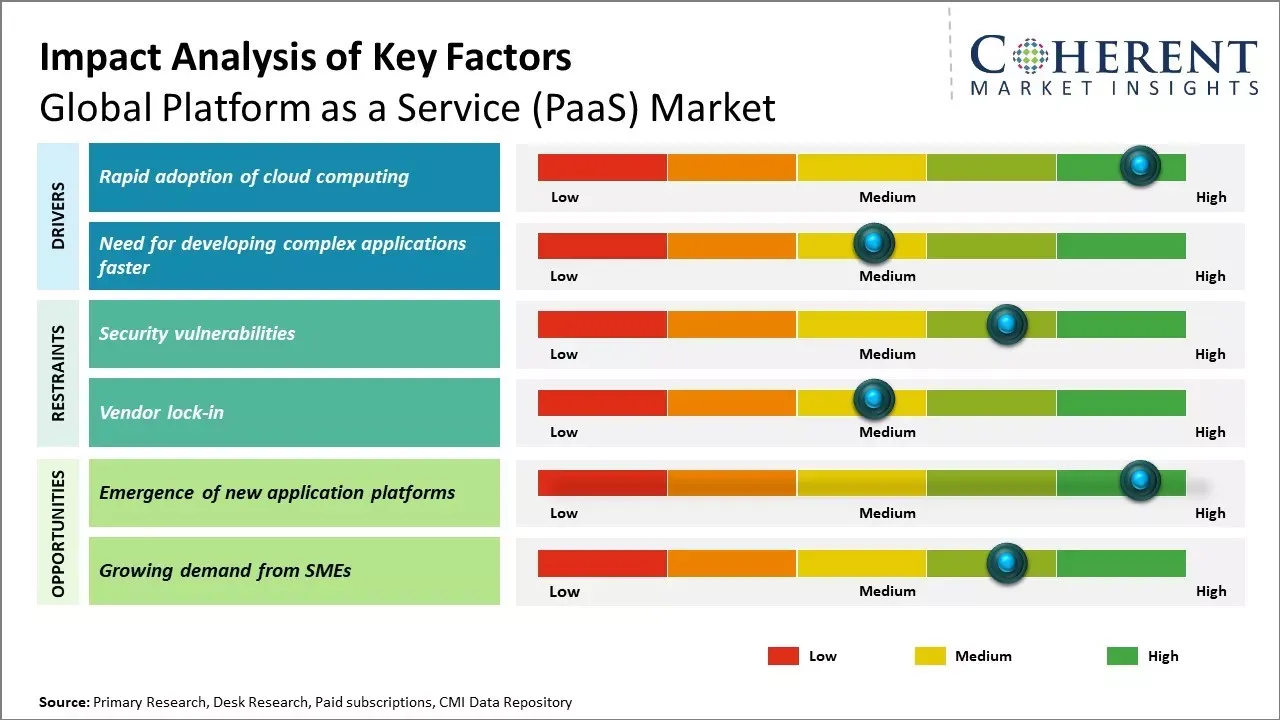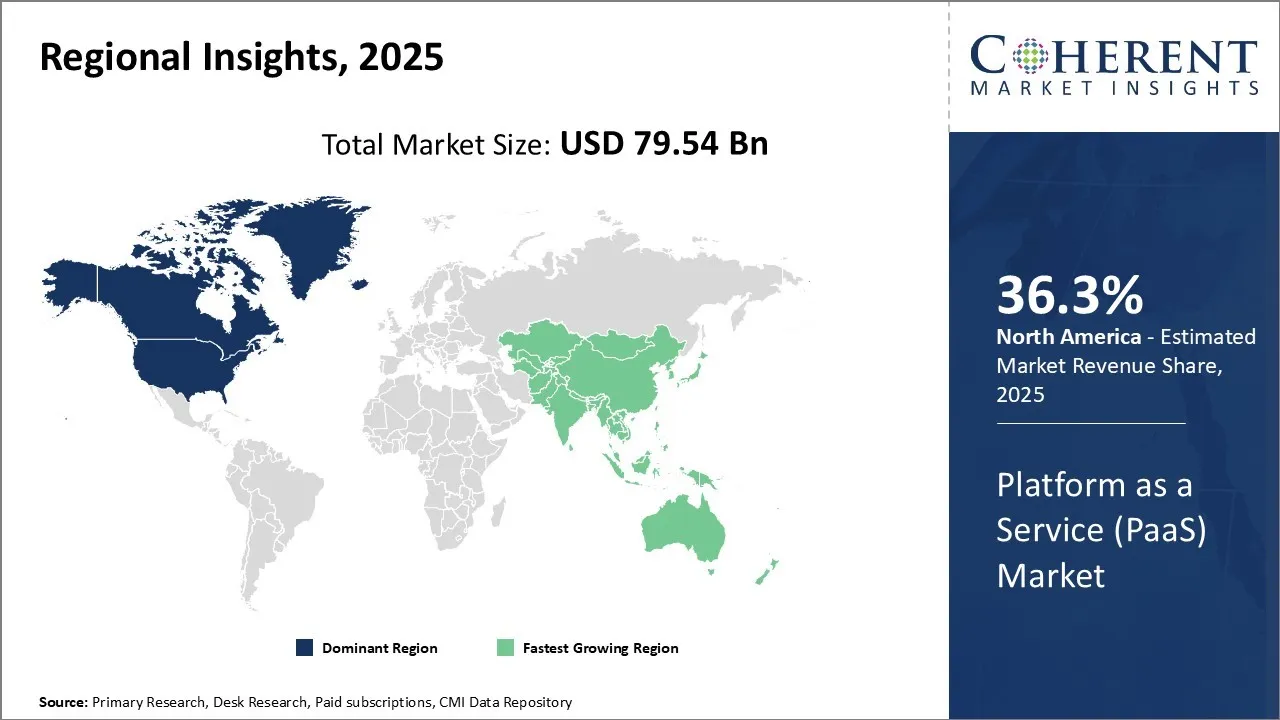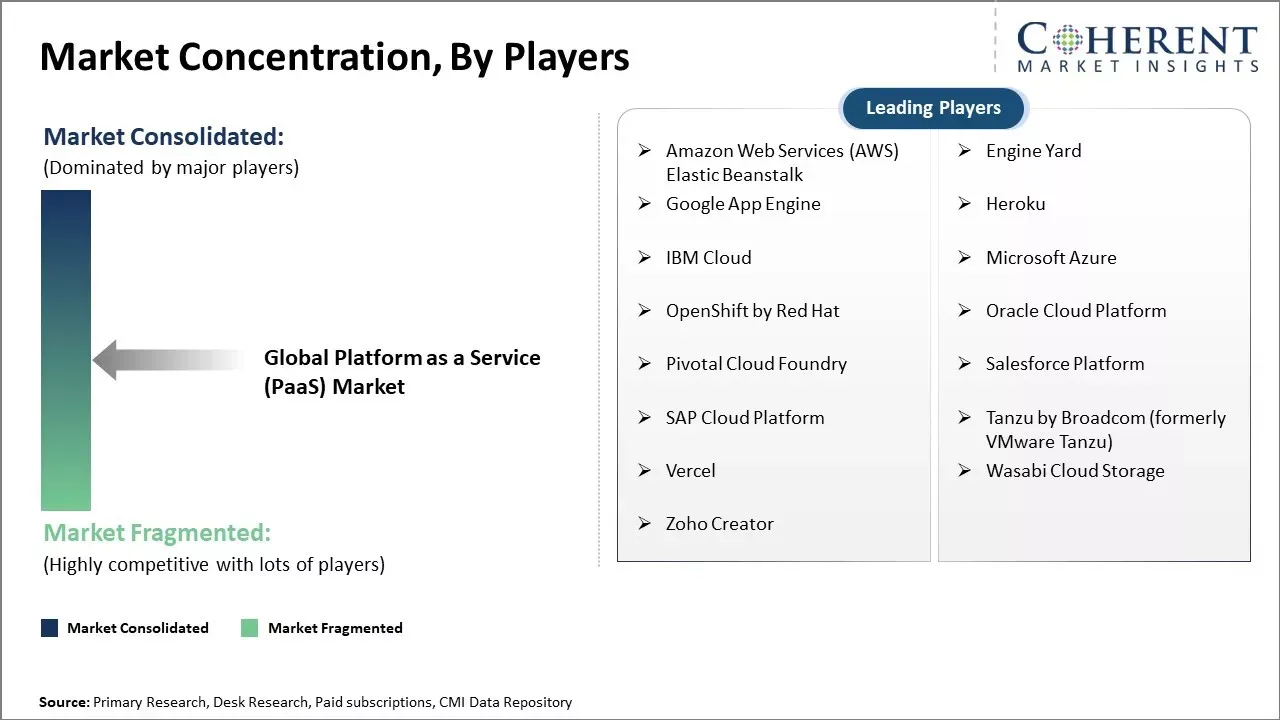The global Platform as a Service (PaaS) market is estimated to be valued at USD 79.54 Bn in 2025 and is expected to reach USD 197.94 Bn by 2032, exhibiting a compound annual growth rate (CAGR) of 13.9% from 2025 to 2032.

To learn more about this report, Download Free Sample
PaaS allows developers to build applications and services using programming languages, libraries, services, and tools supported by the provider to deploy onto the cloud infrastructure. It aids in eliminating the need to buy and manage the underlying infrastructure (servers, storage, and networking). This reduces upfront capital costs and provides more flexibility and scalability compared to on-premises software. The growing adoption of cloud-based platforms and services across enterprises is driving the growth of the Platform as a Service (PaaS) market. PaaS offers organizations a more flexible approach compared to on-premises software and enables them to develop, run, and manage applications without owning the infrastructure.
|
Current Events |
Description and its impact |
|
Compliance & Security Challenges |
|
|
Regional Market Transformations |
|
Uncover macros and micros vetted on 75+ parameters: Get instant access to report
In terms of type, application PaaS (PaaS) is expected to contribute 39.3% share of the market owing to its ability to simplify app development and deployment processes. PaaS platforms provide developers with prewritten code, tools, and a hosted environment so they can focus on designing apps without having to spend time building development infrastructure from scratch. This streamlines the development lifecycle and allows organizations to bring apps to market much faster.
A major factor driving a PaaS adoption is that it eliminates the need for in-house hosting of apps and ongoing maintenance of servers. Developers can quickly create and launch cloud-native apps using a PaaS tools and automatically benefit from the provider's security patching, high availability, and automatic scaling capabilities. This improves agility as developers no longer have to wait on IT teams to provision new servers or troubleshoot hardware issues. They have instant access to cloud resources on demand.
Many PaaS providers also offer rich libraries of pre-integrated services that developers can leverage to add functionality to their apps without additional coding. For example, providers offer prebuilt integrations for authentication, data storage, analytics, payments, and more, simplifying and expediting the development process. Additionally, PaaS supports continuous integration/delivery workflows, allowing fast, automated updates to apps in production. This keeps apps updated with the latest features and fixes quickly.
The pay-as-you-go billing models of PaaS also help minimize upfront costs. Customers only pay for the resources they consume rather than having to invest heavily in buying servers, maintaining data centers, or hiring extra staff to manage infrastructure. This has made PaaS an attractive option, especially for smaller development teams and startups with limited budgets.
In terms of deployment, the public cloud is expected to contribute 61.9% share of the market in 2025, owing to the security, compliance, and scalability benefits it offers over private cloud options. Public cloud platforms are hosted and managed by large providers like AWS, Azure, and Google Cloud, which can invest heavily in physical and cybersecurity measures. They undergo regular external audits to maintain compliance with standards like ISO (International Organization for Standardization, PCI (Payment Card Industry, and HIPAA - Healthcare Insurance Portability and Accountability Act. For most organizations, trusting their applications and data to a cloud giant makes more sense than trying to achieve the same levels of security in-house.
Unlike private clouds with limited infrastructure, the major public cloud vendors have global networks of data centers that provide businesses with geographic data residency options as well as built-in disaster recovery. They can scale elastically based on demand, avoiding over-provisioning of resources. This makes the public cloud ideal for applications that have unpredictable traffic patterns. Most public cloud providers also pass the responsibility of maintenance, patching, and upgrades to their infrastructure onto themselves. So, customers do not have to divert internal resources away from core business activities to manage their private clouds.
For instance, OutSystems launched its cloud-based application platform as a service (PaaS). It stands out as the only PaaS that can be deployed in the cloud, on-premises, or in a hybrid environment, and it generates standard Java.
In terms of end users, manufacturing is expected to contribute 46.7% share of the market in 2025 due to the industry 4.0 digital transformation sweeping this sector. Industry 4.0 focuses on interconnectivity between industrial systems through Internet of Things sensors and cloud/edge computing. PaaS plays a crucial role here by providing scalable platforms for developing and running the thousands of new applications required to digitally instrument entire production facilities and supply chains.
Manufacturers are leveraging PaaS to rapidly create and deploy a wide range of Industry 4.0 applications to optimize operations, from quality inspection apps based on computer vision to predictive maintenance solutions leveraging machine learning on sensor data. PaaS streamlines the efforts required to integrate these applications with industrial IoT devices, enterprise resource planning (ERP) backends, and customer portals.
Additionally, manufacturers are applying PaaS to develop digital twins - virtual replicas of entire plants and products that mirror the physical world. By simulating production processes virtually, digital twins help manufacturers test new processes, minimize waste, and optimize workflows before implementing changes on the physical factory floor. The cloud scalability of PaaS makes it possible to deploy these huge, data-intensive digital twins.

To learn more about this report, Download Free Sample
North America has dominated the global Platform as a Service (PaaS) market. The region is expected to account for 36.3% of the market share in 2025. This can be attributed to the strong presence of technology giants and startup culture in the U.S. Many leading PaaS providers, such as AWS, Microsoft Azure, and Google Cloud, etc. are U.S.-based and were early movers in the space. They have made significant investments over the years to develop robust platforms and an ecosystem that has created a virtuous cycle of innovation.
Several enterprises, especially startups, in domains like retail, healthcare, financial services, etc., have built their applications on these platforms to save costs and focus on their core business. The adoption of PaaS in the region has also been fueled by trends like cloud migration and DevOps. Large enterprises are leveraging PaaS for modernizing legacy applications and improving agility. For instance, in October 2024, Salesforce launched Government Cloud Premium. It is a PaaS designed for U.S. national security and intelligence agencies. This platform enables the development of secure, mission-critical applications. Canada, on the other hand, is still growing. The growth is boosted by the adoption of digital transformation in fields like healthcare, education, etc. Fintech and e-commerce sectors use PaaS for faster scalability.
The Asia Pacific region has emerged as the fastest-growing market for PaaS globally. Rapid digital transformation across industries has accelerated the demand. Countries like China, India, Japan, and Australia are witnessing strong traction due to increasing developer communities. While China dominates the market and is led by giants like Alibaba Cloud, Tencent Cloud, etc. There are also government programs like Made in China that push for technical reliance. India, too, is a fast-growing PaaS market. There is a booming start-up ecosystem in the country with cloud adoption across edtech, fintech, etc. Local PaaS vendors have also come up to address the needs of price-sensitive domestic enterprises and startups.
For instance, in India, several PaaS players are providing affordable platforms to encourage app development and support the government's 'Digital India' initiative, which is further contributing to the platform as a service market demand. Foreign tech companies are setting up local data centers and partnerships to capture this lucrative opportunity. Rapid expansion of the internet and smartphone penetration over the last few years has enabled more organizations to leverage cloud-based platforms. The PaaS market is anticipated to further bolster in Asia Pacific owing to the continued rise of the internet economy and supportive government policies toward digital innovation and entrepreneurship.

To learn more about this report, Download Free Sample
| Report Coverage | Details | ||
|---|---|---|---|
| Base Year: | 2024 | Market Size in 2025: | USD 79.54 Bn |
| Historical Data for: | 2020 To 2024 | Forecast Period: | 2025 To 2032 |
| Forecast Period 2025 to 2032 CAGR: | 13.9% | 2032 Value Projection: | USD 197.94 Bn |
| Geographies covered: |
|
||
| Segments covered: |
|
||
| Companies covered: |
Amazon Web Services (AWS) Elastic Beanstalk, Engine Yard, Google App Engine, Heroku, IBM Cloud, Microsoft Azure, OpenShift by Red Hat, Oracle Cloud Platform, Pivotal Cloud Foundry, Salesforce Platform, SAP Cloud Platform, Tanzu by Broadcom (formerly VMware Tanzu), Vercel, Wasabi Cloud Storage, and Zoho Creator |
||
| Growth Drivers: |
|
||
| Restraints & Challenges: |
|
||
Uncover macros and micros vetted on 75+ parameters: Get instant access to report
The platform as a service model is gaining tremendous popularity as more and more organizations are shifting toward cloud-based applications and services. The on-demand nature of PaaS solutions allows businesses to focus primarily on developing, testing, and scaling applications without worrying about infrastructure maintenance tasks. Traditional application deployment methods required sizable upfront investments in procuring and maintaining servers, storage, databases, and other backend infrastructure. However, with PaaS, companies can avoid capital expenditure and instead pay only for what they use via an operational expenditure model. This has exponentially increased the appeal of the PaaS model for cost-conscious organizations of all sizes. The ease of getting started on a cloud platform, together with the ability to elastically scale resources on demand, is spurring the adoption of PaaS worldwide.
Businesses today need to innovate and bring new applications, features, and services to market at an incredibly rapid pace to stay ahead of the competition. At the same time, they are facing constraints around technical talent availability and resource crunch that slow down development cycles. PaaS solutions have emerged as an effective way to streamline and accelerate application development by abstracting away lower-level infrastructure complexities. Developers can leverage pre-built development and deployment tools, continuously integrated environments, databases, analytics services, and more on cloud platforms to code, test, and deploy apps much more efficiently. This has enabled even non-technical teams to develop sophisticated cloud-native, mobile, and IoT applications. By providing fully managed backend services, PaaS offers an agile and scalable way for organizations to prototype, build, and enhance both new and legacy applications much faster to meet dynamic market needs.
The emergence of new application platforms has the potential to greatly boost opportunities in the global Platform as a Service (PaaS) market. As technology advances rapidly, developers and organizations are constantly seeking innovative ways to build, deploy, and manage applications. The variety of PaaS offerings available has increased tremendously in recent years to meet this growing demand.
New application platforms allow for increased flexibility, agility, and scalability compared to traditional infrastructures. They provide fully-managed developer services and environments that abstract away the underlying infrastructure complexities. This enables organizations and developers of all sizes to focus exclusively on developing innovative applications and solutions without the overhead of procuring and maintaining servers, storage, databases, and other infrastructure components. The platforms automate many routine management tasks like code deployment, configuration, resource allocation, and software upgrades through their web-based portal or API controls.
*Definition: The global Platform as a Service (PaaS) market provides developers with tools and technologies required to build, deploy, and manage applications directly onto the cloud without having to install servers or any other infrastructure. With PaaS, developers can focus on writing code and developing applications without worrying about the underlying cloud infrastructure and services. Common services provided under PaaS include database integration, analytics, web server, software development kits, security, and revenue and usage monitoring. PaaS reduces costs and helps scale applications faster while improving manageability and collaboration for organizations across all industry verticals globally.
Share
Share
About Author
Monica Shevgan has 9+ years of experience in market research and business consulting driving client-centric product delivery of the Information and Communication Technology (ICT) team, enhancing client experiences, and shaping business strategy for optimal outcomes. Passionate about client success.
Missing comfort of reading report in your local language? Find your preferred language :
Transform your Strategy with Exclusive Trending Reports :
Frequently Asked Questions
Joining thousands of companies around the world committed to making the Excellent Business Solutions.
View All Our Clients